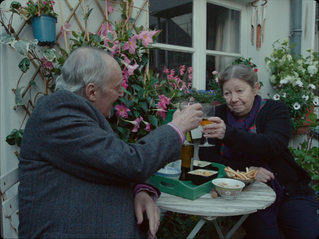Blood for Dracula
- Nick Davie
- Aug 11, 2021
- 4 min read
Paul Morrissey, 1974

As the blood pours like cheap wine, Paul Morrissey parades an impaired and physically weak Udo Kier through an anti-communist, bizarrely conservative, and surreally moralistic caricature of the famous bloodsucker.
The sleaze of this politically charged satire of vampire folklore is palpable; only the blood of a virgin can keep the flailing Count Dracula alive. Anton (Arno Juerging), the manservant of Dracula (Udo Kier), finds hope in a religious pre-fascist Italy for the desolate Count. The latter can only be restored to strength by the blood of a virgin, having seen his family slowly disappear from Romania, searching for the same pure blood (of a virgin). In a weakened state, Dracula tasks Anton with arranging travel immediately to Italy; there, the Count befriends a family of declining wealth, despite owning a lavish estate, of which the patriarch hopes to marry one of four daughters to a wealthy aristocrat. The film comprises a range of softcore eroticism, political satire, lavishly over-the-top gore, and a tacky aesthetic that pulses vividly throughout.
Directed and written by Paul Morrissey, Andy Warhol's name was attached to the film in a loose pseudo-auteur gimmick to promote the film despite no consistent evidence of the latter's contribution aside from attending "the parties". Despite the lack of claim on Warhol's part, there is a clear link between this film and some other x-rated Warhol productions of the same era in their presentation of 'political' sex. Warhol and Morrissey collaborated in some capacity on numerous occasions before Blood for Dracula, exploring politics, exploitation, substance abuse, and sex work in Heat, Flesh, Trash, and Women in Revolt. Though other authorship issues existed, the European release of the film was credited to Antonio Margheriti (Dir; Castle of Blood, Cannibal Apocalypse). This credit as the director ensured the film would obtain Italian nationality for the producers due to Italian laws. Blood for Dracula's production began only one day after Morrissey's Flesh for Frankenstein finished, both produced by the prolific Italian producer Carlo Ponti.
Morrissey deconstructs the legend of Dracula through a political lens; the Count exists as a reminder of his own country's dying aristocracy, his diminishing fortunes cast him into battle with a new foe. The political revolutions of the plot's era pit the bourgeoisie against the proletariat. The aristocratic vampire combats the Marxist family servant Mario for the now-cash-strapped Di Fiore family's socio-economic existence. The Warholian 'political' sex is symbolic to both Dracula and Mario, both lusting over and projecting political identities onto the family daughters. With the Di Fiore family patriarch and matriarch hoping to marry a daughter off to Dracula in hopes of replenishing a diminishing wealth and social status, the socio-economic ramifications of their children's love and lust hold much significance for the plot's progression and conclusion.
Like its precursor Flesh for Frankenstein, Blood for Dracula has achieved some cult film notoriety, owed to its over-the-top gross humour and camp aesthetics. The political elements of the plot are always present, running deeply as an undercurrent in every scene. However, the film is much more successful as a darkly comic exploitation flick than as serious social commentary. Overriding self-indulgence appears to hold every character back from their individual goals and aspirations. Mario, in particular, the Marxist family servant, seduces the daughters who Dracula seeks out as virgins, somewhat believing himself to be saving the young women from capitalism's grasp. In the character of Mario, Morrissey is satirising the Marxist cliches that were present in European arthouse cinema, particularly Italian Neo-realism. Further satirisation is present in the casting of Italian Neo-realist director Vittorio de Sica (Umberto D, Bicycle Thieves) as the Di Fiore family patriarch, a once vain aristocrat, now pragmatic peasant seeking to return to heights of wealth.
In Dracula's death throes, there is comedy in his over-exuberant displays of agony, but under the surface is a character born out of traditional values struggling to survive. Whilst not consistently successful in its message, the film exposes both political factions as opposing forms of subjugation through the Count and Mario. The vampire folklore, Dracula and others have often contained socially classist elements, with the latter in particular, more often than not, an aristocratic, upper-class villain; this is a common theme in many indie or mainstream retellings of the Dracula story, though some vampiric characters have subverted this, from the street searching student vampire in Abel Ferrara's Addiction to the Cullen family of Twilight in their middle-class suburban lifestyle. Blood for Dracula's influence in challenging the conventional vampire story is clear.
The camp overtones in acting and setting add a layer of irony to the thematic pokes at class politics and modernity. The comedy is juxtaposed nicely by the tragically romantic score from Claudio Gizzi; the score fits the plot's period and unbalances the awkwardness of the ironic performances. The outrageous speech about urine, the deadpan gambling scene, and the overzealous portrayal of blood rejection by Kier could all be negatively associated with day-by-day writing during production. Though these negative connotations do not hold, the silliness and camp heighten the titillating affairs that keep any dour class politics commentary manageable. Both Morrissey's Flesh for Frankenstein and Blood for Dracula toy with their conventional themes, resulting in satirical takes on monsters lost within the modernity of changing social landscapes.








Comments